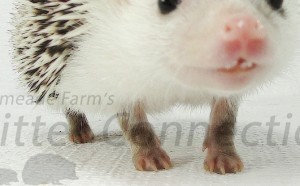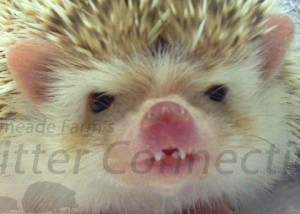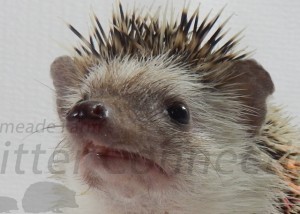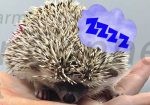Last Updated on November 18, 2021.
Size
- The average hedgehog weighs approximately ½ to 1-¼ pounds and most are the size of a softball or slightly larger when they are rolled into a ball.
- Some adult hedgehogs have a slightly larger build and can weigh up to 2 pounds (the size of a small guinea pig) without being fat.
- Most hedgehogs are 6-8 inches in length, but it is hard to accurately and consistently measure a hedgehog, because their body changes shape when it is balled up, relaxed, sitting or moving.
Teeth
- Hedgehogs have 36-44 teeth in a long, pointy snout.
- The first pair of incisors is slightly larger than the rest, but they are certainly not as dramatically different in size from their other teeth as a rodent’s front teeth.
- Hedgehog incisors do not continuously grow, as do rodent incisors, and so they do not have an innate need to chew or gnaw on things to wear down their teeth.
- The baby teeth are shed early and replaced by rooted adult teeth.
- Poor diet can cause tooth decay and gum disease.
Feet
 Hedgehogs have 4 toes on the rear feet and 5 toes on the front feet in the Atelerix species.
Hedgehogs have 4 toes on the rear feet and 5 toes on the front feet in the Atelerix species.- The nails on the front feet may need trimmed more frequently than the rear feet to prevent them from curling into the foot and damaging the footpad.
- Hedgehogs’ feet and toes are made for walking and running.
- They do not have opposable thumbs or fingers for grasping or vertical climbing.
Tails
- Both sexes have short, stubby tails that are usually hidden under their quills.
- The tail can be confused with a penis because the tail curves toward the head when the hedgehog is placed on its back. The male’s penile sheath and hidden penis are located mid-abdominally.
Chin Mole
- This small bump under the chin is harmless and normal.
- It is often referred to as a “cutie mark.”
Colors
- The Atelerix species tends to have whitish or light colored faces, whereas the Algerian hedgehog has a darker face. Most hedgehog pets today are a hybrid of the two species and the very dark Algerian face masks are fairly rare.
- Hedgehog spines or quills can range in color from an almost black band to a very pale peach color in the banding.
- The spines may be banded or solid white.
- Hedgehogs may actually change color variations as they mature and get older. The best age to determine color is approximately one year.
- The International Hedgehog Association and the Hedgehog Central Web site acknowledge more than 90 different colors of hedgehogs. These colors include various quill colorations, as well as their snowflake and white varieties.
- Quill, skin, face, nose, and leg coloration all come into play when determining the hedgehog’s true color.
- Many hedgehog enthusiasts simplify the colors by placing hedgehogs in a few categories such as standard (black to brown variations), cinnacot (tan or light brown variations), black eyed whites (90% or more white quills), albinos, snowflakes (10-89% white quills), and pintos (any color with patches of white quills).
Odor
- Hedgehogs do not have a scent gland like ferrets and, therefore, do not have a particularly strong body odor.
- Hedgehog urine does not contain large amounts of ammonia like a rabbit or a guinea pig.
- Male hedgehog urine is not stronger than female like male rats, mice, or cats.
- Hedgehogs do defecate and their feces do stink. What a hedgehog eats affects the feces odor. Wet foods and certain brands of foods produce more of an odor than other foods.
- There are products available such as Elimina, that are sprayed on the food or added to the drinking water that help combat odor internally.
- Cage cleaning and bedding choices are important parts of keeping hedgehog smell to a minimum.
VIDEO.: Male vs Female and Hedgehog Scents
Author: Gail Dick, Millermeade Farm’s Critter Connection









